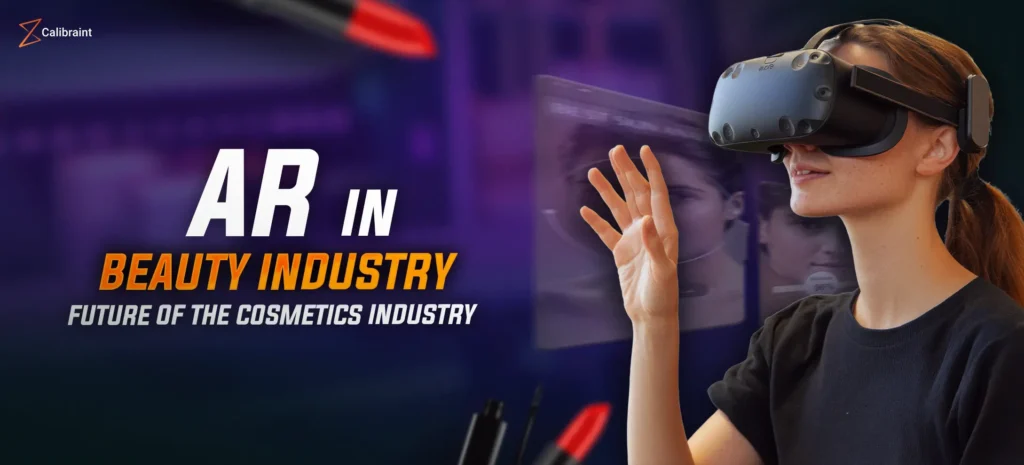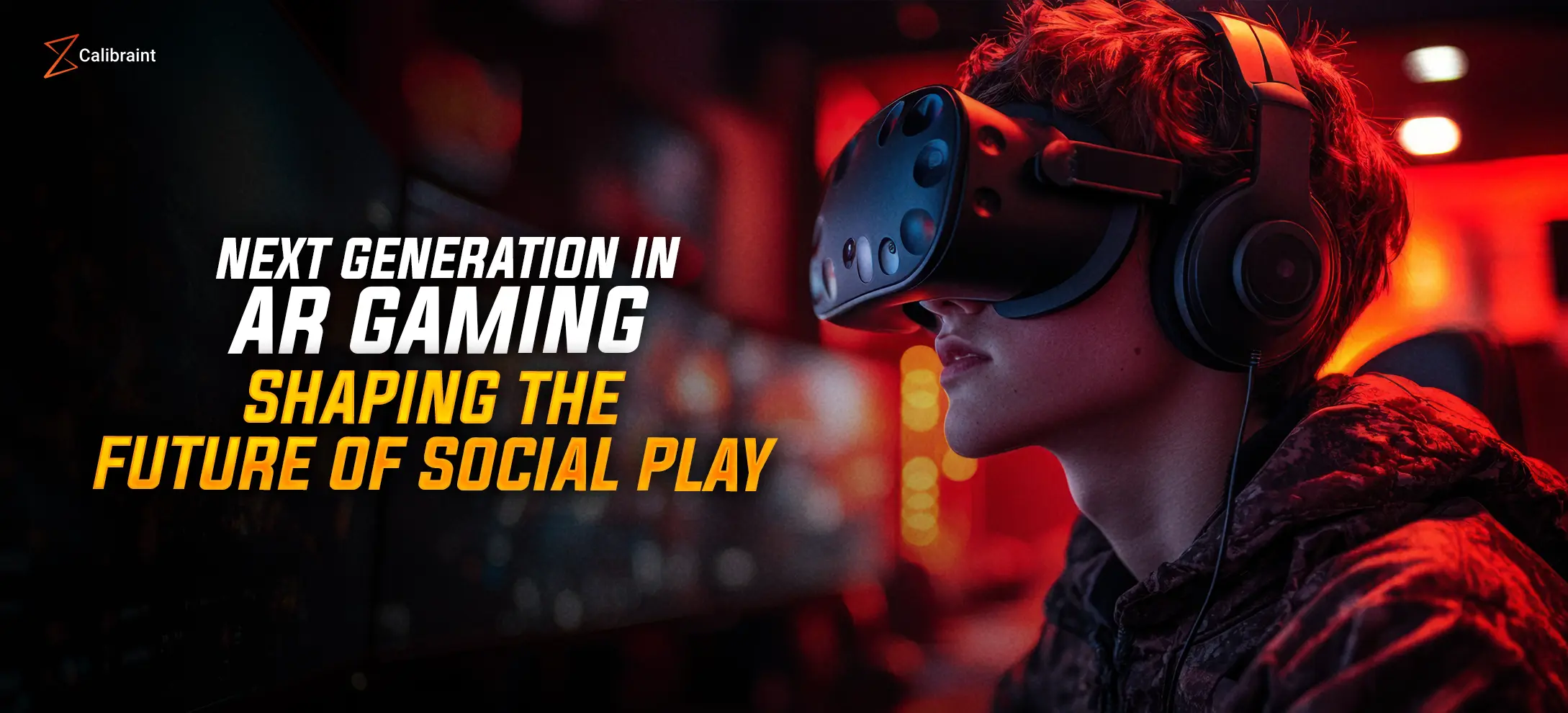AR in Beauty Apps: Transforming the Future of the Cosmetics Industry
Calibraint
Author
September 2, 2025
Last updated: November 14, 2025

In 2024 alone, more than one in three online beauty shoppers used an augmented reality feature before making a purchase. This is not a passing trend, it’s a new standard shaping the way consumers discover, try, and buy cosmetics. The traditional “trial-and-error” model of beauty shopping has been replaced by technology that allows customers to test products virtually with remarkable precision.
This transformation is being powered by AR in beauty apps, where innovation meets personalization. From interactive lipstick try-ons to real-time skincare diagnostics, augmented reality is closing the gap between digital convenience and in-store experiences. For beauty brands, retailers, and service providers, this is more than a tool, it’s a pathway to stronger customer trust, reduced return rates, and higher brand loyalty.
As the global beauty industry races toward a projected $580 billion valuation by 2027, companies that embrace this immersive shift will stand apart. Those who delay risk falling behind in a market where personalization and digital-first engagement are becoming the foundation of consumer choice.
From Static Catalogs to AR-Driven Immersion
Traditional beauty applications provided static images, generic recommendations, and product descriptions. While functional, they often left customers uncertain about shade compatibility or product suitability. This uncertainty led to dissatisfaction and costly returns.
By contrast, AR in beauty apps offers immersive, interactive journeys. Features like real time 3D mask rendering allow customers to preview makeup in motion, while facial recognition technology ensures that recommendations align with their unique features. A digital catalog with AR elevates product discovery into an experience where swiping through items feels as engaging as a real-world store trial.
Why AR in Beauty Apps Matters
1. Personalization that Builds Confidence
Augmented reality allows users to visualize products on their unique skin tone, facial features, or hair type with remarkable accuracy. This level of personalization goes beyond a static catalog, creating a tailored shopping journey. By reducing hesitation and uncertainty, customers feel more assured about their choices. Ultimately, it transforms curiosity into confident purchasing decisions.
2. Reducing Returns, Increasing ROI
Product returns are one of the biggest hidden costs for the beauty industry, often caused by mismatched shades or unmet expectations. AR-powered facial recognition paired with realistic virtual try-ons minimizes this issue by guiding users toward the right fit the first time. Fewer mismatches mean fewer returns, directly improving profitability. Over time, this strengthens both customer satisfaction and overall ROI.
3. Engagement That Translates to Loyalty
An AR-enabled digital catalog isn’t just about browsing—it’s about immersive participation. Customers can experiment with different looks, test products in real time, and enjoy a sense of discovery. This active engagement turns casual shoppers into loyal brand advocates. The result is deeper connections that extend far beyond a one-time purchase.
4. Expanding into Service-Based Models
AR also opens the door for beauty businesses to evolve into hybrid service models. Customers can virtually preview hairstyles before stepping into a salon, test skincare regimens tailored to their needs, or even book treatments directly through the app. This seamless ecosystem integrates product discovery with service engagement, driving long-term growth opportunities.
Global Examples Leading the Change
The real-world applications of AR in beauty apps illustrate its game-changing potential:
- L’Oréal & Modiface: At CES 2023, L’Oréal unveiled the Brow Magic Printer, blending AR and AI to deliver personalized brow styling. This milestone showcased how AR can extend beyond screens to physical product experiences. Read the announcement here.
- Sephora Virtual Artist: Using augmented reality integration, Sephora enabled customers to try thousands of products virtually, boosting conversion rates and redefining digital-first retail.
- MAC Cosmetics: With real time 3D mask tutorials, MAC provided customers with professional-grade makeup lessons, enhancing both education and product sales.
These examples prove that AR is not a novelty, it’s an essential driver of customer engagement and commercial impact. For a deeper look at how immersive technologies are reshaping industries beyond beauty, explore our blog on next-generation AR in gaming and social play.
Ready to Bring AR into Your Brand?
The next wave of beauty innovation is already here. Brands that integrate immersive solutions like AR in beauty apps will lead in personalization, customer loyalty, and revenue growth.
🔗 Talk to Our iOS App Development Experts
The Technology Behind AR in Beauty Apps
For organizations considering adoption, the foundation lies in understanding the technology stack powering these experiences:
- Augmented Reality Integration: Embedding AR seamlessly into mobile ecosystems ensures smooth, frictionless performance for users.
- Facial Recognition Technology: Advanced algorithms map facial structures with precision, enabling hyper-personalized beauty recommendations.
- Digital Catalog with AR: Static product lists are reimagined as interactive trial spaces where customers can virtually test items.
- Real-Time 3D Mask Rendering: Lifelike overlays adapt to facial movements and lighting, creating realistic try-on experiences.
- On-Demand Beauty App Integration: AR blends with service booking platforms, offering customers a unified and convenient journey.
Each component enhances the overall value proposition, creating apps that are not just functional but transformational.
Unlocking New Business Models
The integration of AR in beauty apps is not just about enhancing customer experiences; it’s opening doors to entirely new business models. Companies can now diversify their offerings and create fresh revenue streams that blend personalization, technology, and convenience.
Direct-to-Consumer Brands
With AR-powered try-ons, direct-to-consumer beauty brands can break down traditional online shopping barriers. Customers can visualize lipsticks, foundations, or hairstyles on themselves in real time, leading to more confident purchases. This level of personalization drives e-commerce conversions and establishes stronger brand trust.
Retailers
Brick-and-mortar retailers and online stores alike are adopting AR to merge the best of physical and digital shopping. A digital catalog enriched with AR enables shoppers to test products virtually, compare shades instantly, and bridge the gap between in-store trials and online browsing. The result is higher engagement and more seamless omnichannel experiences.
Salons and Spas
AR integration also empowers service-based businesses such as salons and spas. Clients can preview hairstyles, nail art, or skincare treatments before committing to appointments, eliminating guesswork. This reduces dissatisfaction, strengthens trust, and positions the business as a tech-driven innovator in personal care.
Marketplaces
Beauty-focused marketplaces can scale faster by collaborating with an iOS app development company or Android specialists to integrate AR features. By offering brands and sellers the tools to showcase products in lifelike formats, marketplaces attract both customers and partners, fueling platform-wide growth and competitiveness.
This versatility allows beauty enterprises to innovate beyond product lines and tap into experiences, services, and communities.
Challenges and Considerations
As with any transformative technology, deploying AR in beauty apps comes with challenges:
- Scalability: Delivering smooth and consistent AR experiences across a wide range of devices and platforms can be complex.
- Data Protection: With facial recognition at the core, safeguarding sensitive biometric data is critical to building trust.
- User Adoption: Customers may hesitate initially, so guiding them through AR features ensures comfort and confidence.
- Implementation Costs: Upfront investments can be high, but long-term ROI from reduced returns and higher sales justifies the spend.
Enterprises that address these considerations strategically will be well-positioned to lead in a rapidly evolving market.
The Role of Mobile App Development
Behind every successful AR experience lies a strong mobile app foundation.
- An iOS app development company leverages ARKit to deliver precise AR rendering for Apple devices.
- An Android app development company builds ARCore-driven solutions optimized for diverse Android ecosystems.
- Custom development combines augmented reality integration, real time 3D mask, and digital catalog with AR into applications designed for enterprise scalability.
Calibraint’s expertise lies in merging immersive experiences with robust mobile development, enabling beauty brands to transform digital engagement into measurable business impact.
Looking Ahead
The future of AR in beauty apps goes beyond virtual lipstick swatches. Emerging trends include AI-powered skin diagnostics, immersive beauty tutorials, and AR wearables that adapt recommendations in real time.
As technology matures, beauty brands will transition from selling products to creating ecosystems of experiences. Early adopters will define industry benchmarks, while those who hesitate risk being left behind in a digital-first marketplace.
Conclusion
The beauty industry has always thrived on reinvention, but AR in beauty apps represents a seismic shift. By integrating facial recognition technology, digital catalog with AR, and immersive features like real time 3D masks, brands can achieve personalization at scale, drive revenue, and future-proof their customer experience strategies.
Organizations that seize this opportunity today won’t just adapt to consumer expectations—they will set the pace for the industry’s future.
Lead the Future of Beauty with AR
The era of immersive beauty is here. Whether it’s creating personalized digital catalogs or developing on demand beauty app platforms, the opportunity to differentiate is vast.
🔗 Partner with Calibraint for AR-Powered Mobile App Development
Calibraint
Author
September 2, 2025
Last updated: November 14, 2025























